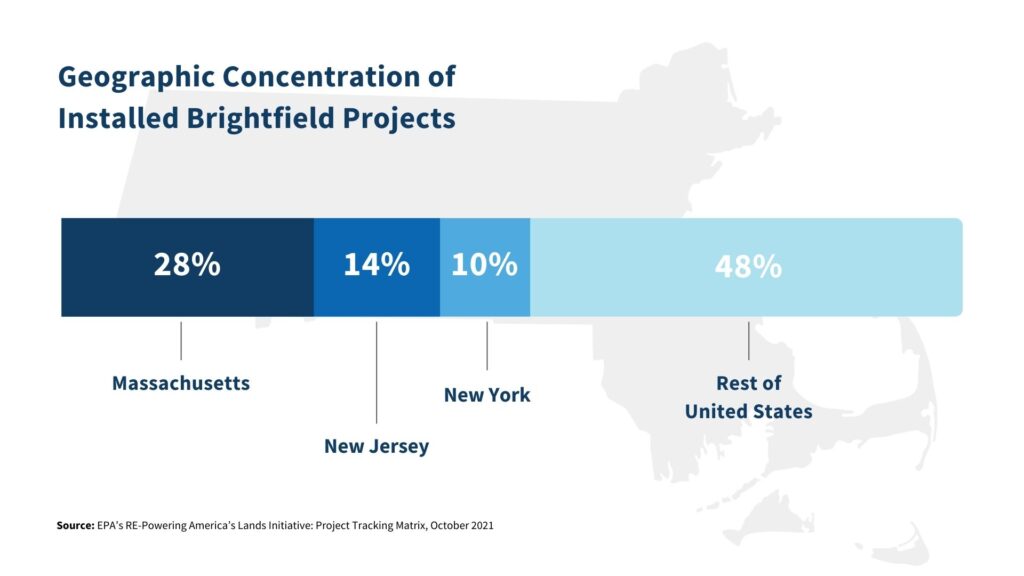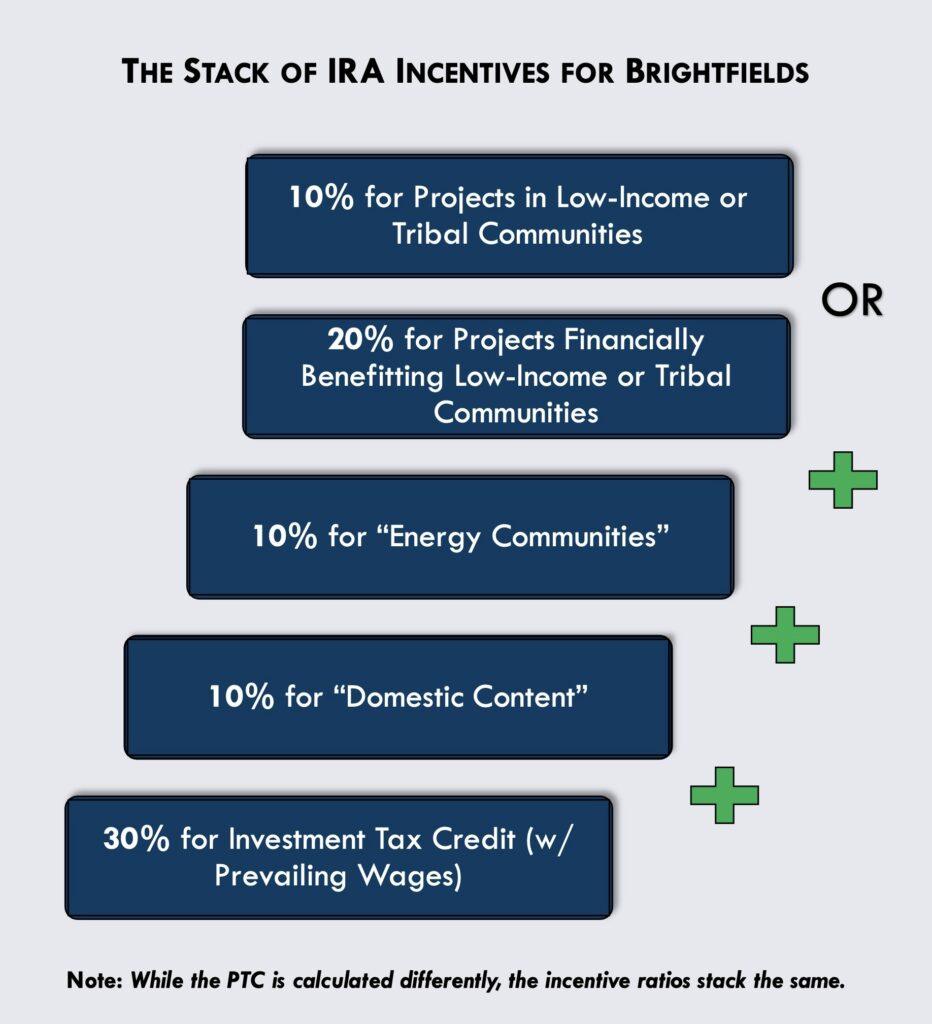
The industrial revolution fundamentally reshaped America’s economy but left behind a legacy of brownfields—land that is potentially contaminated, and often neglected and underutilized. These kinds of sites are far more common than you may think, and include closed landfills, shuttered coal plants and mines, inactive steel mills, and abandoned factories. The EPA estimates that there are over 450,000 brownfield sites across America. For too many communities, these brownfields are daily reminders of past productivity and the struggle to redevelop sites that may pose health and safety hazards.
However, deploying clean energy (typically solar) on brownfields to convert them into “brightfields” is an often overlooked, under-discussed opportunity that can deliver multiple community benefits and contribute to an equitable, clean energy transition. These benefits include:
- Sustainably reusing already developed land to reduce the need to build on undeveloped land, farms, and other agricultural land.
- Reinvesting in sites that often lack other redevelopment options, especially closed landfills and Superfund sites.
- Helping to address past environmental injustices by safely repurposing hazardous sites that were too often sited in or near lower income and marginalized communities.
- Supporting a clean energy economy and local jobs by co-locating on-site clean energy with new manufacturing and other energy-intensive facilities, such as green hydrogen production and data centers.
Communities are starting to take advantage of these benefits with innovative projects such as Pittsburgh’s 2 megawatt rooftop solar on a former steel mill at Hazelwood Green, Annapolis’ Solar Park on a closed landfill, and Houston’s forthcoming Sunnyside Energy solar project on a closed landfill.
But despite these impressive examples and the huge opportunity brightfields offer, most local governments and site owners struggle to repurpose these more complicated sites, and energy developers struggle to find feasible sites ready for reuse. To effectively and strategically advance brightfield projects across the U.S., communities need to understand the potential of brightfields, how the newly passed Inflation Reduction Act makes brightfields more financially attractive, and where they can get technical assistance in deploying them.
The potential of brightfields is significant
Through October 2021, the EPA has tracked only 459 completed brightfields projects totaling a mere 1.9 gigawatts of clean energy capacity. Yet, the agency has pre-screened more than 190,000 brownfields nationwide for possible clean energy deployment, and estimates a potential for hundreds of gigawatts (GW) of clean energy. And the completed projects are highly concentrated geographically, with 52% of completed brightfields built in just 3 states: Massachusetts, New Jersey, and New York. In other words, we’ve only just started to scratch the surface of what’s possible for brightfields.

Additionally, RMI’s report, The Future of Landfills is Bright, estimates that America’s closed landfills alone could host at least 63 GW of solar, enough to power 7.8 million American homes or the entire state of South Carolina. Brightfields are poised to play a major role in the energy transition.
How the Inflation Reduction Act will help
The Inflation Reduction Act (IRA) extends two of the primary economic drivers of clean energy—the Investment Tax Credit (ITC) and Production Tax Credit (PTC). Brightfields, like any clean energy project, will be able to take advantage of these broadly applicable clean energy tax credits. More importantly, for the first time ever, the IRA includes federal incentives that explicitly support brightfields and the communities where brownfields are most common:
- “Energy Communities”: This provision creates a 10% tax credit bonus for solar and wind projects sited on brownfields; in areas with significant employment in coal, oil, gas extraction or processing since 2000; or, in or adjacent to a census tract where a coal mine closed since 2000 or coal unit retired since 2010.
- Projects In or Serving Low-Income Communities: This provision also creates two incentives for low-income community-oriented projects up to 5 MWs:
- 10% tax credit bonus for solar and wind facilities located in qualifying low-income communities or on Tribal land.
- 20% tax credit bonus for projects that financially benefit low-income or Tribal communities, most likely through a community solar-type structure. Projects are defined as “benefitting” these groups if at least 50% of the financial benefits of the project go to households with incomes less than 200% poverty line or incomes less than 80% of an area’s gross median income.
Because closed landfills, Superfund sites, and other brownfield sites were often located in disadvantaged and marginalized communities, these two incentives work in tandem to encourage brightfields reinvestment in lower income areas that were home to or bordered industrial and other fossil-fuel intensive operations. Taken together, these two incentives dramatically shift where investment in the clean energy economy will likely be prioritized.
The new Energy Communities and Low-Income Communities tax credit incentives can fundamentally alter the equation for projects depending on where they are sited and who they benefit. In fact, for projects meeting all these criteria, it’s possible to achieve a 70% investment tax credit. At this level, more costly, complex projects that had previously struggled to pencil out financially may now get a green light.

What is Direct Pay?
Did you know that for the first time ever, the Inflation Reduction Act enables tax-exempt entities to claim direct payment instead of tax credits for qualifying projects? This opens the door for projects to be owned by tax-exempt entities (i.e., municipalities, states, Tribes, publicly-owned utilities, religious institutions, and other non-profits). Before this, these entities were ineligible to directly capture the benefits of federal tax credits because they did not pay federal taxes.
RMI is launching a brightfields accelerator
The Rocky Mountain Institute is partnering with the Kansas State University’s (KSU) Technical Assistance to Brownfields program to launch the first-ever accelerator for brightfields projects to create a broader project development pipeline for the market. This program will include technical assistance, tools, and other resources to help local governments, site-owners, and community partners make smart and sustainable choices about the reuse and revitalization of brownfield sites and prepare for funding, financing, and procurement for clean energy. We will help communities understand and leverage the new IRA incentives that encourage clean energy projects on brownfields and in low-income communities.
This technical assistance builds directly on RMI’s years of experience as one of the leading technical partners to major cities through the American Cities Climate Challenge’s Renewables Accelerator. In this initiative, RMI helped cities small and large across America implement their climate action plans and collectively procure over 500 MW of clean energy. Now, RMI will be enhancing the brightfields toolbox and helping communities prepare for brightfields development.
The U.S. energy system has always required land—from coal mines to oil rigs to natural gas pads. Unquestionably, the energy transition will need open areas to host solar panels, wind farms, and other clean energy facilities. The good news is that brownfields of all types—including closed landfills, old industrial areas, and even abandoned mines—can be part of the solution if developed safely, strategically, and in accordance with environmental regulations.
Given the enormous untapped potential of these sites and new IRA incentives, the time is ripe to shift brightfields from an emerging practice to a mainstream opportunity. Doing so will enable communities of all shapes and sizes to embrace and benefit from the clean energy transition.
Matthew Popkin is manager of urban transformation at the Rocky Mountain Institute. This article was originally published at RMI’s website and is republished here with permission.
Weekly Newsletter
Get building science and energy efficiency advice, plus special offers, in your inbox.















0 Comments
Log in or create an account to post a comment.
Sign up Log in